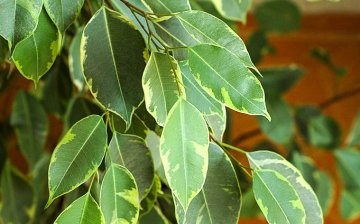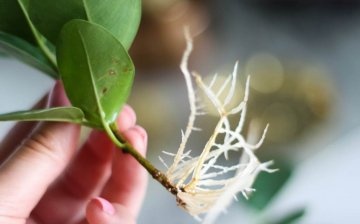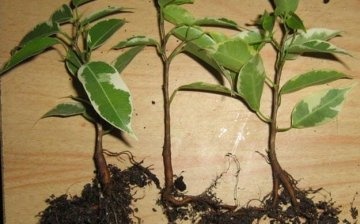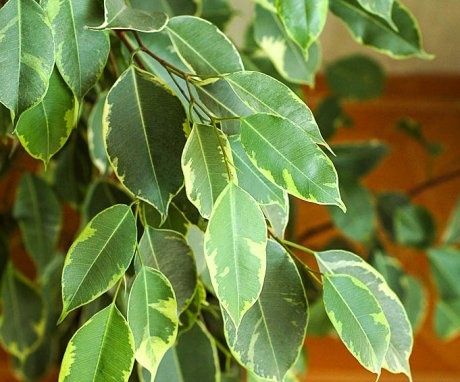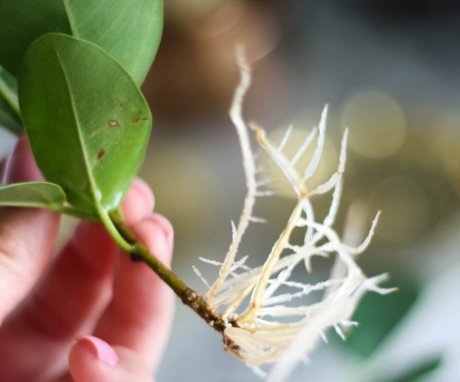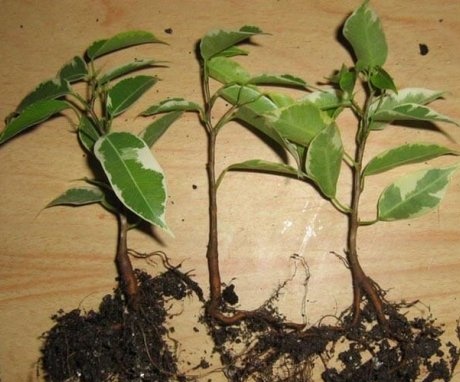Methods for breeding ficus Benjamin at home
Thanks to the vitality and endurance of Benjamin's ficus, propagating a plant at home is considered a feasible task. However, there are a number of rules that must be followed to guarantee success. The subtleties of this event are discussed in the article.
When can Benjamin's ficus be propagated
Ficus is one of the popular houseplants used to decorate the interior. Intense shoot growth and bright green foliage will transform a room for any purpose. Culture looks great in a small apartment and a large country house. The exotic handsome man conquered the hearts of flower growers not only with high aesthetic qualities, but also with undemanding care. It has a culture and useful properties, which are expressed in the ability to cleanse the air from hazardous chemical compounds (benzene, trichlorethylene, phenol, etc.).
The flower is easy to propagate using one of the available methods. It is better to plan these events in the spring or summer. In the fall, a period of dormancy begins. Until the onset of spring, the plant rests, gains strength. At this time, the release of new shoots and foliage is reduced. You should not injure the ficus by cutting cuttings or leaves, there is a high probability of a weakening of the protective function.
Reference! A favorable time for transplanting ficus is the period from May to August.
Reproduction methods
Propagate ficus Benjamin can be done using one of the possible methods.
Cuttings
This method involves the use of lignified shoots. The length of the workpiece should be 10-15 cm. If the stalk is slightly lower or higher, the same is not scary. When planting a thin base, you will need to install a support.
Cut off shoots must be placed in water. While the slices are cleared of milky juice, you should choose a rooting method. It is imperative to remove the milky juice by soaking the cut. If left on the cutting, the hardened crust will interfere with the formation of roots and new growth.
Layers
If the plant gives a small increase in shoots, the layering method can be used to propagate the ficus. To get a new flower, follow these steps.
- On the mother plant, a shoot with a length of 40-50 cm is selected.
- On it, they outline the place in which it is planned to grow roots.
- Remove 2-3 sheets in the selected area.
- Make two circular incisions in the bark, observing an interval of up to 3 cm between them.
- Remove the bark in the intermediate area.
- Apply Kornevin to the exposed part of the shoot.
- Fix sphagnum moss in this place, moisten it with a spray bottle.
- Close this area with a strip of polyethylene and fix the twist with threads.
- Check the moisture level of the moss periodically. If necessary, spray it with warm water.
- After the branches of the root appear around the moss, the cutting is cut below the level of the root system.
- The resulting cut is planted in a separate pot. And the place where the mother plant is cut is treated with a solution of activated carbon and wax.
The process of obtaining layering takes approximately 2-2.5 months. Subject to the humidification regime, the result is always positive.
Leaves
This method is only called leaf, but for harvesting planting material, a leaf plate with a petiole and a small part of the stem are required.
The first cut is made under the bottom leaf.An indent of 1 cm is made from it. Further, 1 cm retreat from the cut line and again make a cut-off. The next incision is marked above the second sheet. As a result, there are as many blanks as there are cut fragments with leaves.
After soaking the cuttings to remove the milky juice, they are buried in the soil mixture. The pot is chosen to be roomy, so that all the slices can freely fit in it. Drainage is introduced at the bottom of the container with a layer of 3-4 cm. The substrate is chosen light and loose. The most successful option is a composition based on peat and fertile land. The shoots are buried in the soil to the base of the petiole.
The blanks should be positioned along the edge of the container so that the sheet tilts slightly over the sides. For quick rooting, the planting is covered with polyethylene or a glass vessel, periodically moistened. The process of forming the root system takes about 2-3 months. After that, the young plant can be transplanted.
Seeds
To grow ficus benjamin you can even use seeds. They are very small, so they use a magnifying glass and a wooden stick for sowing. The period favorable for the germination of planting material falls in February - April. In the absence of heat, the time is extended until July.
Reference! In the process of growing seedlings, artificial lighting may be required to increase daylight hours (it should be at least 10-12 hours).
For planting, a shallow container is chosen, which is filled with a mixture of sand and turf. The substrate is not poured to the edges (they leave the sides 3-5 cm). The surface of the soil mixture is moistened with warm water from a sprayer. They slap the makeshift garden bed with their palm a little.
Seeds are applied to the prepared substrate with a stick, trying to distribute them evenly over the container. To keep the grain on the edge of the stick, it is pre-moistened in water.
The planting is sprinkled with fine-structured soil, creating a 3 mm layer. To retain moisture in the ground, a polyethylene frame is installed on the top of the container. In a greenhouse environment, seedlings should appear after 5-8 weeks.
With an interval of 3-4 days, the crops are aired. The first leaf appears 40-50 days after germination. A transplant is required when young shoots reach the age of 2.5-3 months.
When transferring them to separate pots, you need to check that the depth of the root collar is the same as in the container.
How to do it right
First you need to prepare everything you need. Do not forget about the disinfection of the products used.
Required materials and tools
In the process of harvesting cuttings you will need:
- mother plant;
- container;
- filler;
- container with water;
- pruner or sharp knife;
- alcohol solution or other disinfectant;
- root formation stimulant.
Step-by-step instruction
It is easier to work on harvesting and rooting cuttings if you adhere to this sequence.
- First stage. Choose lignified or semi-lignified shoots on the mother plant, the length of which reaches 5-15 cm. They should have 2-3 nodes. You can cut the cuttings both from the top and side branches.
- Second phase. Make an incision with pruning shears under the lower bud. In this case, the secateurs are installed at an angle of 45 °. Sections of cuttings must be treated with a means that activates the development of the root system (for example, Kornevin). This will speed up the rooting process.
- Stage three. To remove the milky juice released at the incision site, you need to place the cuttings in a container with warm water. Soak the workpieces in liquid for an hour.
- Fourth stage. Fill the container with sand or a mixture of peat and perlite. Other fillers are also suitable: perlite, vermiculite, sphagnum moss. After light moistening, plant the cutting in a container.
- Fifth stage. Cover the container with a glass jar or glass. They contain the workpieces in a warm room at a stable temperature of 25-26 °.Periodically, the filler is slightly moistened. After 2-3 weeks, the stalk produces thin root processes.
Breeding features
The tools used to work with the plant must be sterile. For this, the cutting part is treated with an alcohol solution or other antiseptic. If the cuttings are harvested from different bushes, then after each flower it is necessary to disinfect. This will prevent healthy flowers from becoming infected.
In the ground
For rooting in the soil, a substrate is prepared from turf soil, sand and peat. All components are disinfected in the oven by heating. After that, they are mixed and introduced into the planting container.
Reference! Small pots are suitable for rooting 1-2 cuttings. If there are more blanks, it is better to use a rectangular container of appropriate parameters.
The shoot, after cleaning from the milky juice, is buried in the soil mixture by 2-3 buds. The soil is lightly compacted and moistened with a spray bottle. To create a greenhouse effect, sticks are installed along the edges of the container, a transparent plastic bag is fixed on top of them. The frame should be higher than the planting material. A warm environment and moderate humidity is required for successful rooting.
In water
Rooting cuttings in water is considered less troublesome. It is enough to put the workpieces in a container with liquid. The container should not transmit light, therefore, when using a glass container, flower growers wrap the outer wall with foil or a dense dark cloth. It is also necessary to build something like a greenhouse on top of the handle. The simplest option involves fixing a plastic cup.
When rooting the cuttings in water, the microclimate is set close to the natural habitat of ficuses. This is a temperature within 25 ° and an average humidity level.
Maintenance of an impromptu greenhouse is minimized:
- 2-3 holes are made in the bottom of the plastic cup for free air passage;
- as the water evaporates, make gravy;
- after the appearance of the roots, the structure is dismantled for the subsequent transplant of the shoot.
Tips from experienced florists
Beginners in floriculture should read the advice of experts. This will help to avoid many mistakes that often occur when growing and reproducing ficuses.
- As a blank, you can use cuttings with 1 eye and 1 leaf.
- From each branch of the plant, you can get as many cuttings as there are leaves on it.
- To stimulate rapid rooting, an incision must be made at the bottom of the workpiece. When using a lignified shoot, a cruciform incision is made.
- The greenhouse effect activates the development of the root system. In addition to constructing a frame over the cuttings, a warm substrate should be used when filling the container.
- To accelerate root formation, it is recommended to use phytohormones during plant propagation.
Regardless of the variety of ficus, growers choose young shoots for reproduction (no more than 2 years old). Cuttings from older shoots do not root well, but they can also be used in combination with stimulants.
Watch a video with an experiment on rooting a ficus:



